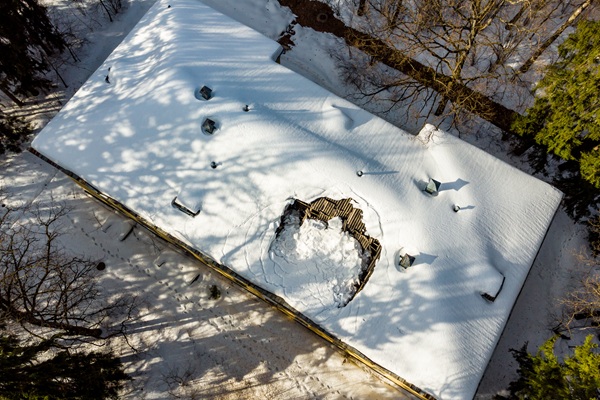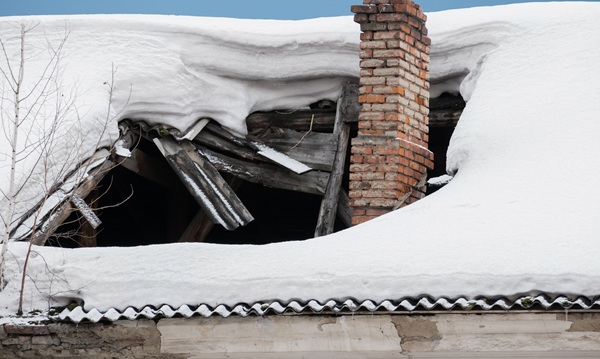Winter brings snow, and snow brings weight. Roofs fail when that weight exceeds what the structure was built to carry but figuring out where that threshold sits is not as simple as measuring depth with a yardstick. Storm patterns, building age, roof pitch, and the type of snow sitting up there all play a role in how close you are to trouble. Some roofs shed accumulation naturally.
Others trap it in valleys and behind obstacles where it compacts, gets heavier, and stays put until spring. The difference between safe and dangerous often comes down to details most homeowners never think about until warning signs appear—and by then, the margin for error has already shrunk. If you are asking how much is too much, the real answer starts with how roofs handle load in the first place.
How Roof Snow Load Capacity Is Determined
Capacity depends on roof design, materials, local building codes, and the current condition of the roof. Pitch, span, truss, or rafter layout, and how loads transfer to walls and foundations all factor in. Steeper slopes shed snow more efficiently, while low-slope or flat roofs retain accumulation that compacts and gains weight over time. Age matters—older homes may have been built to standards that differ from current codes, potentially affecting their capacity to handle modern snow load requirements.
Total roof load is calculated as Dead Load plus Live Load. Dead load represents the permanent weight of structural components: sheathing, shingles, underlayment, ventilation systems, and any mounted equipment like HVAC units or solar panels. Live load covers temporary forces such as snow, ice, rain, and wind, typically specified in pounds per square foot (psf) by local building codes.
Converting snow depth into psf requires accounting for density. Fresh, light powder weighs approximately 3-5 pounds per cubic foot. Packed or settled snow increases to 15-20 pounds per cubic foot. Wet, heavy snow can reach 20-40 pounds per cubic foot, and ice weighs roughly 57 pounds per cubic foot. This means one foot of wet snow can weigh two to three times more than the same depth of fresh powder.
Snow accumulation is rarely uniform across a roof. Drifts form along valleys, behind parapets, at roof level changes, and on leeward slopes where wind deposits additional snow. These concentrated areas can hold significantly more weight than average depth measurements suggest. Roof features like skylights, chimneys, and dormers create pockets where snow collects and remains longer.
Local building codes establish minimum snow load requirements based on historical weather data and regional climate patterns. These requirements vary significantly—mountain communities may require roofs to handle 60-100+ psf, while areas with minimal snowfall may specify 20-30 psf. Codes also account for factors like roof slope, roof configuration, and exposure category based on terrain and surroundings.
Because site conditions vary—wind exposure, microclimates, roof age, and maintenance history all influence actual capacity—professional evaluation is the most reliable way to confirm what your roof can handle. Licensed structural engineers and certified roofing contractors can assess framing dimensions and spacing, connection integrity, condition of decking, and fastener adequacy. They compare these elements against current code requirements and local weather patterns to determine whether your roof meets standards or needs reinforcement.
Typical Snow Loads by Roof Type
Roof shape and slope work together to determine how efficiently snow sheds and how much accumulation the structure must support over time. Sloped roofs naturally release snow as it builds up, reducing the sustained load the framing carries, while flat or low-slope roofs allow snow to settle, compact, and increase in density—all of which adds weight that remains until temperatures rise enough for melting or someone removes it manually. Steeper pitches encourage snow to slide off before significant buildup occurs, but low-slope systems must be engineered to handle higher live loads since they retain accumulation longer and may need periodic clearing to prevent structural stress. Local building codes establish minimum design loads based on decades of regional climate data, and these requirements serve as the baseline for evaluating what your specific roof should be able to handle under typical winter conditions.
Materials play a direct role in capacity by affecting dead load, which is the permanent weight the roof structure carries before any snow arrives. Heavier roofing materials like concrete or clay tile add substantial dead load that reduces the remaining margin available for snow, ice, and other live loads, while lighter systems such as asphalt shingles or metal roofing impose less permanent weight and leave more capacity for variable loads when combined with properly sized framing members. Roof pitch affects snow shedding in measurable ways that building codes account for when calculating design requirements—roofs with pitches of 6:12 or steeper tend to shed snow naturally once temperatures rise above freezing, while lower pitches of 4:12 and below retain snow longer since gravity alone isn’t sufficient to overcome friction between the snow and roofing surface. Flat roofs or those with pitches under 2:12 hold snow until it melts or someone removes it, which is why building codes often apply reduction factors for steeper roofs that allow lower design snow loads based on the expectation that natural shedding will limit accumulation.
Surface characteristics also influence how long snow remains on the roof and how much weight accumulates over time. Smooth metal roofs shed snow more readily than textured asphalt shingles because there is less friction to hold the snowpack in place, and dark-colored roofing materials absorb more solar radiation, which accelerates melting and encourages release during sunny winter days. Proper attic insulation and ventilation prevent interior heat from escaping through the roof deck, which would otherwise melt snow at the surface only to have it refreeze at the eaves and form ice dams that block natural drainage, add concentrated weight along roof edges, and create conditions for leaks when meltwater backs up under shingles.
Regional climate drives the design requirements that local jurisdictions enforce through building codes. Northern states and mountain communities typically require design snow loads of 30-60 psf or higher—with some mountain zones exceeding 100 psf—because these areas experience heavy, persistent snowfall that creates substantial roof loads season after season. These requirements reflect historical snowfall patterns and include consideration for ground snow load, which is the measured snowpack on the ground converted to roof snow load through calculations that account for roof exposure to wind, thermal properties that affect melting and refreezing, and configuration factors like valleys and level changes where drifts accumulate. Areas with minimal snowfall may specify design loads of 20 psf or less since the statistical likelihood of severe snow events is lower, and structures do not need the same margin of safety.
Local jurisdictions adopt building codes that reference national standards like the International Building Code (IBC) or International Residential Code (IRC), both of which include detailed snow load maps and calculation methods that engineers and builders use to determine site-specific requirements. These codes factor in roof slope since steeper pitches shed snow, exposure category that distinguishes between exposed ridgelines and sheltered locations, roof configuration complexity that affects drift patterns and unbalanced loading, and importance factors based on building occupancy that require higher safety margins for structures where collapse would endanger many people or disrupt critical services.

Warning Signs of Excessive Roof Snow
Visible sagging in the roof deck, ridgeline, or ceiling is the most critical warning sign of excessive snow load and requires immediate attention. Even slight dips or bowing indicates the structure is under stress beyond its design capacity. Interior signs include cracks appearing in drywall or plaster, particularly near the center of rooms or along walls where the ceiling meets. Doors and windows that suddenly stick or will not close properly can signal structural movement from roof stress. Popping, cracking, or creaking sounds from the roof or attic—especially during additional snowfall—indicate framing members under strain. Water stains on ceilings or walls may point to roof movement that has compromised flashing or created gaps in the roofing system.
Outside, look for gaps between exterior walls and the roof structure, or separation at joints and connections. Roof-mounted equipment like satellite dishes, vents, or chimneys that appear to have shifted position suggest the roof deck has moved. Large icicles and ice dams along eaves, while common in winter, become a concern when combined with other warning signs because they add concentrated weight and prevent proper drainage. If you observe any of these signs, reduce interior loads by moving heavy items from upper floors. If possible, avoid disturbing the roof structure, and contact a structural engineer or roofing professional immediately. Do not attempt to clear snow yourself if structural damage is suspected—additional weight or vibration from movement on the roof could trigger failure.
Safe Snow Removal from Your Roof
Safety must come first when considering roof snow removal. Never climb on a snow-covered roof—surfaces are slippery; structural integrity may be compromised by excessive load, and falls from heights cause serious injuries or fatalities. Ice dams, hidden obstacles, and unstable footing make roof access dangerous even for experienced individuals. If you can safely reach lower sections from the ground, use a roof rake with an extended handle designed specifically for snow removal. Pull snow downward in small sections, working from the eave upward, and stay clear of areas where snow will fall. Remove only a few feet of snow at a time rather than attempting to clear the entire roof, which can create unbalanced loads. Never use sharp tools, metal shovels, or ice chippers that can puncture or tear roofing materials.
Avoid using salt, calcium chloride, or other ice-melting chemicals on roofing surfaces—these can damage shingles, corrode metal components, harm landscaping below, and contaminate groundwater. Do not create channels or pathways through snow by removing narrow strips, as this concentrates remaining weight in specific areas and can overload structural members. If snow depth exceeds two feet, if ice dams are extensive, if the roof pitch is steep, or if any warning signs of structural stress are present, stop and call professionals.
Professional snow removal services have the equipment, training, and insurance to handle the job safely and effectively. Crews use proper safety gear including harnesses, non-slip footwear, and fall protection systems. They assess structural conditions before beginning work and remove snow in patterns that maintain balanced loads throughout the process. Professionals can identify and address ice dams, clear valleys, and problem areas where drifts accumulate, and inspect for damage that homeowners might miss.
For homes in areas with regular heavy snowfall, establishing a relationship with a professional snow removal service before winter allows for scheduled or on-call service when accumulation reaches concerning levels. This proactive approach prevents emergency situations and ensures your roof receives care that protects both the structure and the people involved.
Preventative Winter Roof Care
Safety must come first when considering roof snow removal. Never climb on a snow-covered roof—surfaces are slippery, structural integrity may be compromised by excessive load, and falls from heights cause serious injuries or fatalities. Ice dams, hidden obstacles, and unstable footing make roof access dangerous even for experienced individuals. If you can safely reach lower sections from the ground, use a roof rake with an extended handle designed specifically for snow removal. Pull snow downward in small sections, working from the eave upward, and stay clear of areas where snow will fall. Remove only a few feet of snow at a time rather than attempting to clear the entire roof, which can create unbalanced loads. Never use sharp tools, metal shovels, or ice chippers that can puncture or tear roofing materials.
Avoid using salt, calcium chloride, or other ice-melting chemicals on roofing surfaces—these can damage shingles, corrode metal components, harm landscaping below, and contaminate groundwater. Do not create channels or pathways through snow by removing narrow strips, as this concentrates remaining weight in specific areas and can overload structural members. If snow depth exceeds two feet, if ice dams are extensive, if the roof pitch is steep, or if any warning signs of structural stress are present, stop and call professionals.
Professional snow removal services have the equipment, training, and insurance to handle the job safely and effectively. Crews use proper safety gear including harnesses, non-slip footwear, and fall protection systems. They assess structural conditions before beginning work and remove snow in patterns that maintain balanced loads throughout the process. Professionals can identify and address ice dams, clear valleys, and problem areas where drifts accumulate, and will inspect the roof for damage that homeowners might miss. They carry liability insurance that protects you if accidents occur during removal—something that does not exist when you attempt the work yourself or hire unlicensed help.
For homes in areas with regular heavy snowfall, establishing a relationship with a professional snow removal service before winter allows for scheduled or on-call service when accumulation reaches concerning levels. This proactive approach prevents emergency situations and ensures your roof receives care that protects both the structure and the people involved.
FAQs: Snow Load on Roofs
Here are some of the most common questions we receive about how roof load and local weather conditions can impact the lifespan of a roof:
How much does 10 inches of snow weigh?
Weight varies with density. Light, fresh snow weighs approximately 3-5 pounds per cubic foot, translating to roughly 0.5-1 psf per inch of depth. Heavy, wet snow weighs 15-20 pounds per cubic foot, or about 1.5-2 psf per inch. Packed or compacted snow increases to 20-30 pounds per cubic foot. Ten inches of light powder might weigh 5-10 psf, while ten inches of wet snow could reach 15-20 psf or more. Ice adds significantly more—about 5 psf per inch. Depth alone does not tell the full story. Temperature fluctuations, moisture content, wind compaction, and freeze-thaw cycles change snow density quickly during and after storms.
How much snow is needed to collapse a roof?
No single depth guarantees failure. Roofs are designed to meet local snow load standards—typically 20-40 psf in moderate climates, 40-70 psf in snowier regions, and 70-100+ psf in mountain areas—but actual capacity depends on roof age, condition, slope, materials, and how snow accumulates. A roof rated for 40 psf could handle two feet of light powder (roughly 20-30 psf) but fail under one foot of heavy, wet snow combined with ice (potentially 50+ psf). Unbalanced loads from drifts, valleys, or roof level changes create concentrated stress that exceeds average capacity. Rain falling on existing snow adds weight rapidly—water-saturated snow can double or triple in weight. Warning signs include creaking or popping sounds, sagging roof sections, sticking doors or windows, new cracks in walls or ceilings, and visible deflection. If any of these appear, move people and valuables away from affected areas and contact a structural professional immediately.
What can homeowners do to reduce risk?
Remove excess snow safely using a roof rake from the ground, focusing on lower sections, and avoiding climbing onto the roof. Maintain proper attic insulation and ventilation to prevent heat loss that creates ice dams. Keep gutters and downspouts clear to ensure meltwater drains properly. Schedule regular roof inspections, especially before winter, to identify structural weaknesses, damaged materials, or inadequate framing. For aging roofs or homes in high-snow areas, professional assessment confirms whether your roof meets current code requirements. If capacity is uncertain or your roof shows signs of wear, replacement with properly engineered systems designed for local snow loads provides long-term protection and peace of mind.
Key Takeaways
- Roofs fail under excessive snow weight, influenced by factors like design, age, and snow type.
- Snow load capacity combines dead load and live load, requiring careful calculation of accumulated snow density.
- Warning signs of excessive roof snow include sagging, cracking, and shifting structures—act immediately to avoid danger.
- Professional snow removal is vital; never attempt it yourself if signs of structural stress appear.
- Regular maintenance and inspections can help prevent roof failures during heavy snowfall seasons.
Time for a Roof Replacement? Contact DaBella!
Winter weather tests roofs hard. Sagging sections, recurring leaks, and persistent ice dams mean your roof may not be handling snow loads safely. If your roof shows these problems or was built to outdated standards, replacement restores the capacity your climate demands.
DaBella holds GAF Master Elite certification, earned by fewer than 3% of roofing contractors nationwide. We install GAF asphalt shingles and metal roof systems built for durability and weather resistance. Asphalt shingles offer impact resistance and advanced sealing. Metal roofs deliver excellent durability, snow-shedding performance, and longevity in heavy snowfall regions. All installations can include the GAF Golden Pledge Warranty covering materials and workmanship.
Contact us today at 844-DaBella to schedule a roof assessment and find a GAF system that fits your home and climate.

